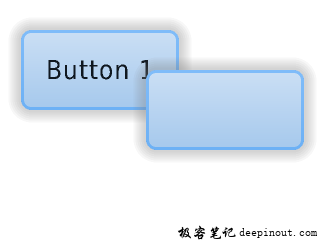LVGL创建对象层级顺序
默认情况下,LVGL在背景上绘制旧对象,在前景上绘制新对象。
例如,假设我们向父对象添加了一个名为 button1 的按钮,然后又添加了另一个名为button2的按钮。 由于先创建了 button1,所以 button1 会被 button2 及其子对象覆盖。

/*Create a screen*/
lv_obj_t * scr = lv_obj_create(NULL, NULL);
lv_scr_load(scr); /*Load the screen*/
/*Create 2 buttons*/
lv_obj_t * btn1 = lv_btn_create(scr, NULL); /*Create a button on the screen*/
lv_btn_set_fit(btn1, true, true); /*Enable to automatically set the size according to the content*/
lv_obj_set_pos(btn1, 60, 40); /*Set the position of the button*/
lv_obj_t * btn2 = lv_btn_create(scr, btn1); /*Copy the first button*/
lv_obj_set_pos(btn2, 180, 80); /*Set the position of the button*/
/*Add labels to the buttons*/
lv_obj_t * label1 = lv_label_create(btn1, NULL); /*Create a label on the first button*/
lv_label_set_text(label1, "Button 1"); /*Set the text of the label*/
lv_obj_t * label2 = lv_label_create(btn2, NULL); /*Create a label on the second button*/
lv_label_set_text(label2, "Button 2"); /*Set the text of the label*/
/*Delete the second label*/
lv_obj_del(label2);LVGL将图层设到前台(foreground)展示
有几种方法可以将对象置于前台:
- 使用
lv_obj_set_top(obj,true)。如果 obj 或它的任何子对象被点击,那么 LVGL 将自动将该对象带到前台。它的工作原理类似于PC机上典型的GUI,当点击背景中的窗口时,它会在前台展示。 - 使用lv_obj_move_foreground(obj) 显式地告诉库将对象带到前台。类似地,使用
lv_obj_move_background(obj)将对象 obj 移动到背台。 - 当使用
lv_obj_set_parent(obj,new_parent)时, obj 将在new_parent的前面。
LVGL顶层和系统层
LVGL 有两个特殊的图层; layer_top 和 layer_sys 。两者在显示器的所有屏幕上都是可见且通用的。 但是,它们不会在多个物理显示器之间共享。 layer_top 始终位于默认屏幕 ( lv_scr_act() )的顶部, layer_sys 则位于 layer_top 的顶部。用户可以使用 layer_top 来创建一些随处可见的内容。例如,菜单栏,弹出窗口等。如果启用了 click 属性,那么 layer_top 将吸收所有用户单击并充当模态。
lv_obj_set_click(lv_layer_top(), true);layer_sys 也用于LVGL。例如,它将鼠标光标放在那里以确保它始终可见。
 极客笔记
极客笔记